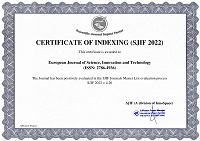The Role of Gender in Technology Adoption and Diffusion in the United States
Abstract
The purpose of this paper is to explore gender differences between men and women in the use of information and communication technology, with special focus on the frequency and intensity of use. Put in another way, to determine whether gender makes a difference in computer and internet use between men and women. Further, it explores whether differences in internet and computer use, “gender bias” or “gender gap” in technology use does indeed exist between the genders. Moreover, this research helps to inform whether such disparities have changed in recent years, reasons for concern, by how much, factors that are responsible and what should be done to eliminate gender-gap in technology adoption and usage. While reviewing numerous and available literature on gender and technology adoption and diffusion, necessary to contribute to knowledge on the subject, this research concludes that there exists gender-gap in computer and internet use in favor of males over females because of differences in factors such as socialization, modeling, anxiety or levels of comfort in technology-use and gender-related stereotypes. This research concludes with the recommendation of proper mitigation policies, steps and actions necessary to drastically reduce or eliminate the gender gap in technology adoption and usage that include but not limited to early socialization for girls, early exposure of girls in STEM fields, involvement of more females in technology training and deployment of high skilled and achieving females in engineering and computer fields as role models and mentors for aspiring females in the computer fields and related industries.
References
Barrett, E. & Lally, V. (1999). Gender Differences in an On-line Learning Environment. Journal of Computer Assisted Learning, 15(1), 48-60.
Bressers, B. & Bergen, L. (2002). Few university students reading newspapers online. Newspaper Research Journal, 32(2/3), 32-45.
Canter, L. & Canter, M. (1991). Parents on your side: A Comprehensive Parent Involvement Program for Teachers. Lee Canter and Associates, USA.
Cotten, S. R. & Jelenewicz, S.M. (2006). A disappearing Digital Divide among College Students? Social Sciences Computer Review, 24(4), 497-506.
Dennis, A.R., Kinney, S. T., & Hung, Y. T. (1999). Gender Differences in the Effects of Media Richness. Small Group Research, 30(4), 405-437.
Eck, J. et al. (1999). An Educator’s Guide to Access Issues. http://lrs.ed.uiuc.edu/wp/access/index.html.
Eimeren, B.V., Gerhard, H., & Fress, B. (2004). ARD/ZDF- Online Studies. Accessed on 29 June 2009.
Ferris, S. P. (1996). Women On-Line: Cultural and Relational Aspects of Women's Communication in On-Line Discussion Groups. Interpersonal Computing and Technology, 4(3/4), 29-40.
Fortson, B.L. et al. (2007). Internet Use, Abuse, and Dependence among Students at a Southeastern Regional University. Journal of American College Health, 56(2), 137-144.
Gruber, S. (1999). Communication Gone Wired: Working Toward Practiced Cyberfeminism. Information Society, 15(3), 199-208.
Hargittai, E. & Shafer, S.M. (2006). Differences in actual and perceived online skills: The role of gender. Social Science Quarterly, 87(2), 432-448.
Heimrath, R., & Goulding, A. (2001). Internet Perception and Use: A Gender Perspective, Program, 35(2), 119-134.
Herring, S. (1994). Gender Differences in Computer-Mediated Communication: Bringing Familiar Baggage to the New Frontier. Keynote Paper at American Library Association annual convention.
Herring, S. C. (1999). The Rhetorical Dynamics of Gender Harassment Online. Information Society, 15(3), 151-168.
Jackson, L.A., Ervin, K.S., Gardner, P.D., & Schmitt, N. (2001a). Gender and the Internet: Women Communicating and Men Searching. Sex Roles, 44, 363-379.
Jackson, L.A. et al. (2001b). The Racial Digital Divide: Motivational, Affective and Cognitive Correlates of Internet Use. Journal of Applied Social Psychology, 31(10), 2019-2043.
King, J. et al. (2002). An Investigation of Computer Anxiety by Gender and Grade. Computers in Human Behavior, 18(1), 69 -84.
Liu, Z. & Huang, X. (2008). Gender Differences in the Online Reading environment. Journal of. Documentation, 64(4), 616-626.
Lorence, D. & Park, H. (2007). Gender and online health information: a partitioned technology assessment. Health Information and Libraries Journal, 24, 204-209.
Morahan-Martin, J. & Schumacher, P. (2000). Incidence and Correlation of Pathological internet use Among College Students. Computers in Human Behavior, 16, 13-29.
Nelson, L., et al. (1991). Getting started with computers: Experience, anxiety, and relational style. Computers in Human Behavior, 7, 185-202.
National Telecommunications and Information Administration /NTIA (1998). Falling Through the Net II: New Data on the Digital Divide. Retrieved from http://www.ntia.doc.gov
Odell, P.M. et al. (2000). Internet Use among Male and Female College Students. Cyber Psychology & Behavior, 3(5), 855-862.
Rodino, M. (1997). Breaking out of Binaries: Reconceptualizing Gender and its Relationship to Language in Computer-Mediated Communication. Journal of Computer-Mediated Communication, 3(3).
Sakamoto, A. (1994). Video game use and the development of socio-cognitive abilities in children: three surveys of Elementary School Students. Journal of Applied Social Psychology, 24.
Savicki, V., Kelley, M., & Lingenfelter, D. (1996). Gender, Group Composition, and Task Type in Small Task Groups Using Computer-mediated Communication. Computers in Human Behavior, 12(4), 549-565.
Savicki, V., Lingenfelter, D., & Kelley, M. (1996). Gender, Language, Style, and Group Composition in Internet Discussion Groups. Journal of Computer-Mediated Communication, 2(3).
Savicki, V., Kelley, M., & Oesterreich, E. (1999). Judgments of Gender in Computer- Mediated Communication. Computers in Human Behavior, 15(2), 185-194.
Shashaani, L. (1993). Gender-Based Differences in Attitudes toward Computers. Computers and Education, 20(2), 169-181.
Shashaani, L. (1994). Socioeconomic Status, Parents' Sex-role Stereotypes, and the Gender Gap in Computing. Journal of Research on Computing in Education, 26(4), 433-451.
Shashaani, L. (1995). Gender Differences in Mathematics Experience and Attitude and their Relation to Computer Attitude. Educational Technology, 35(3), 32-38.
Shashaani, L. (1997). Gender Differences in Computer Attitudes and Use among College Students. Journal of Educational Computing Research, 16(1), 37-51.
Shashaani, L. & Khalili, A. (2001). Gender and Computers: Similarities and Differences in Iranian College Students' Attitudes toward Computers. Computers and Education, 37(3-4), 363-375.
Soukup, C. (1999). The Gendered Interactional Patterns of Computer- Mediated Chatrooms: A Critical Ethnographic Study. Information Society, 15(3), 169-176.
Stuhlmacher, A. F. & Walters, A.E. (1999). Gender Differences in Negotiation Outcome: A Meta-analysis. Personnel Psychology, 52(3), 653-677.
Swanson, J. (1999). What We Can Do to Get Girls Involved in Technology.
Sherman, R.C. et al. (2000). The Internet Gender Gap among College Students: Forgotten but Not Gone? Cyber Psychology & Behavior, 3(5), 885-894.
Slate, J.R. et al. (2002). The “Digital Divide”: Hispanic college Students’ Views of educational Uses of the internet. Assessment & education in Higher education, 27(1), 75-93.
Teo, T.S.H. & Lim, V.K.G. (1997). Usage Patterns and Perceptions of the Internet: The Gender Gap. Equal Opportunities International, 16(6/7), 1-8.
Todman, J. (2000). Gender differences in computer anxiety among university entrants since 1992. Computers and Education, 34(1), 27-35.
U.S. Department of Commerce. (August 2011). Women in Stem: A Gender Gap to Innovation – ESA-Issue brief #04-11, pp. 1-10.
Wachte, R.M. (1999). The Effect of Gender and Communication Mode on Conflict Resolution. Computers in Human Behavior, 15(6), 763-782.
Wright, C. R. (2014). 5 Key barriers to educational technology adoption in developing world. Educational Technology Debate: Exploring ICT and Learning in Developing Countries. Retrieved from https://edutechdebate.org/2014-ict4edu-trends/5-key-barriers-to-educational-technology-adoption-in-the-developing-world/
Winker, G. (2005). Internet Research from a Gender Perspective. Searching for differential use patterns. Journal of International Communication and Ethics in Society, 3(4), 199-207.
Wolin, D. L, & Korgaonkar, P. (2003). Internet Research: Electronic Networking. Web Advertising: Gender Differences Applications and Policy, 13(5), 375-385.
Wilder, G., Mackie, D., & Cooper, J. (1985). Gender and Computers: Two Surveys of Computer Related Attitudes. Sex Roles, 13, 3-4.
Witmer, D. F., & Katzman, S. L. (1997). On-Line Smiles: Does Gender Make a Difference in the Use of Graphic Accents? Journal of Computer-Mediated Communication, 2(4).
Whitley, B. E., Jr. (1996). Gender Differences in Computer-related Attitudes: It depends on What You Ask. Computers in Human Behavior, 13(1), 1-22.
Yates, S. J. (1997). Gender, Identity and CMC. Journal of Computer Assisted Learning, 13(4), 281-290.
Zdenek, S. (1999). Rising from the MUD: Inscribing Gender in Software Design. Discourse and Society, 10(3), 379-409.
Zhang, Y. (2002). Comparison of Internet Attitudes between Industrial Employees and College Students. Cyber Psychology & Behavior, 5(2), 143-149.
Copyright (c) 2025 Ngozi Caleb Kamalu, Hannah Oluchi Kamalu

This work is licensed under a Creative Commons Attribution 4.0 International License.


 ISSN
ISSN 











